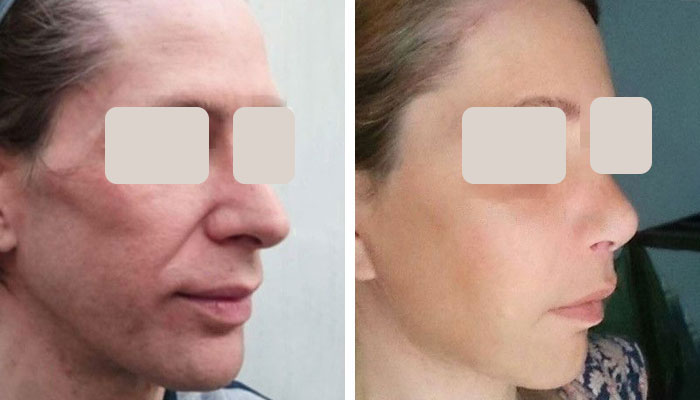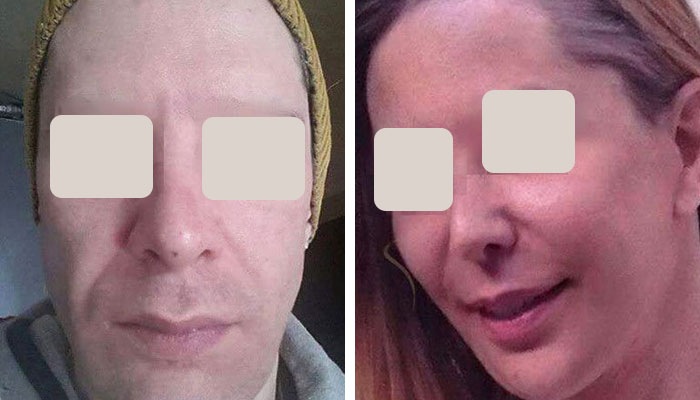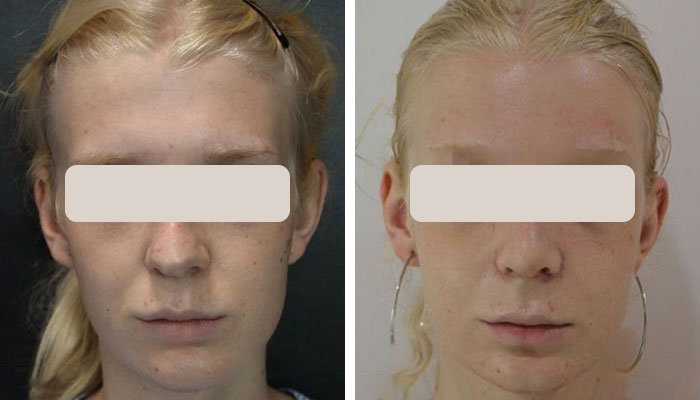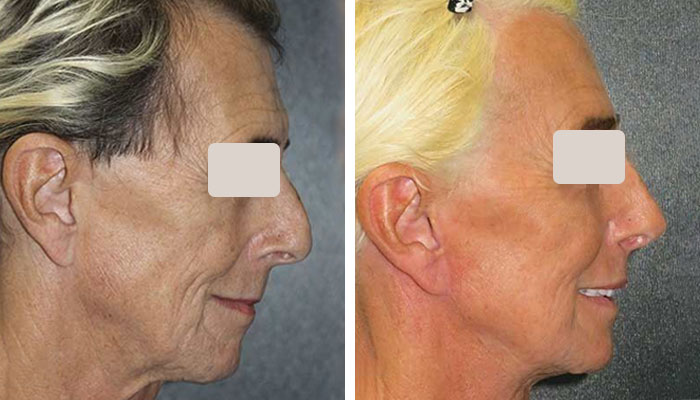What is facial feminization surgery?
Facial feminization surgery (FFS) is a set of surgical procedures designed to alter facial features to create a more feminine appearance. It is commonly sought by transgender women or individuals who wish to enhance their facial femininity.
FFS typically includes a combination of procedures that may involve reshaping the forehead, brow bone, nose, cheeks, jawline, chin, and Adam's apple. These procedures can include forehead contouring, brow lift, rhinoplasty, cheek augmentation, lip augmentation, jawline reduction, chin reshaping, and tracheal shave, among others.
The specific procedures performed during FFS vary depending on the individual's goals and needs. The goal is to create a more harmonious and feminine facial structure that aligns with the individual's gender identity.
FFS requires careful planning, skilled surgical techniques, and individualized treatment plans. It is important to consult with a qualified plastic surgeon or craniofacial surgeon who specializes in FFS to discuss your goals and expectations, as well as to understand the potential risks and benefits associated with the procedures involved.
Why do people have facial feminization surgery?
People undergo facial feminization surgery (FFS) for various reasons, primarily to align their physical appearance with their gender identity. Here are some common motivations for seeking FFS:
- Gender dysphoria: Transgender women or individuals with gender dysphoria may experience significant distress due to their facial features not aligning with their gender identity. FFS can help alleviate the distress and improve their overall well-being.
- Social integration: FFS can assist individuals in achieving a more feminine appearance, which can enhance their ability to navigate social situations and be perceived as their true gender. This can contribute to improved self-esteem and confidence.
- Passing and authenticity: For many transgender women, FFS is a way to enhance their chances of "passing" as female in society, meaning being perceived and accepted as their identified gender. It can help them feel more authentic and reduce the risk of facing discrimination or misgendering.
- Personal satisfaction: FFS allows individuals to align their physical appearance with their inner sense of self. It can provide a sense of congruence between their gender identity and their outward presentation, leading to increased personal satisfaction and happiness.
- Psychological well-being: FFS has the potential to positively impact an individual's mental health by reducing gender dysphoria and improving body image. It can contribute to a greater sense of wholeness and overall psychological well-being.
It is important to note that the decision to undergo FFS is deeply personal and varies for each individual. It is crucial for individuals considering FFS to consult with qualified healthcare professionals specializing in transgender healthcare to discuss their goals, expectations, and potential risks involved.
Am I a good candidate for facial feminization surgery?
While facial feminization surgery (FFS) can be beneficial for many individuals seeking to feminize their facial features, there are certain factors that may make someone a less suitable candidate for the procedure. Some factors that may indicate someone is not a good candidate for FFS include:
- Unstable health condition: Individuals with significant underlying health issues or unstable medical conditions may not be suitable candidates for surgery. It is important to have a thorough medical evaluation to ensure that the individual can safely undergo and recover from the procedure.
- Unrealistic expectations: If a person has unrealistic expectations or motivations that are not aligned with the potential outcomes of FFS, they may not be a good candidate. It is important to have a clear understanding of the limitations and realistic goals of the procedure.
- Psychological readiness: FFS is a major surgical procedure that can have a significant impact on an individual's appearance and identity. Candidates need to have a stable psychological state and a realistic understanding of the emotional and psychological adjustments that may be necessary post-surgery.
- Insufficient gender transition process: FFS is often considered as part of a comprehensive gender transition process. Candidates who have not undergone appropriate counseling, hormone therapy, or social transition may be advised to complete these steps before considering FFS.
- Medical contradictions: Some medical conditions or medications may contraindicate FFS. Certain blood disorders, clotting disorders, or medications that increase the risk of bleeding may make someone a less suitable candidate for surgery.
It is crucial to consult with a skilled and experienced surgeon who specializes in FFS to determine if you are a good candidate. They will evaluate your individual circumstances, medical history, and goals to provide personalized recommendations and ensure that FFS is appropriate and safe for you.
What procedure does FFS include?
Facial feminization surgery (FFS) may include a variety of procedures depending on the individual's specific needs and goals. Some of the common procedures that are often performed as part of FFS include:
- Forehead contouring/brow lift: This procedure involves reshaping the forehead to reduce any prominent brow bone or create a more rounded and feminine hairline.
- Rhinoplasty: Nose reshaping surgery is performed to make the nose appear more feminine by adjusting the size, shape, and proportions of the nose.
- Cheek augmentation: Cheek implants or fat grafting can be used to enhance the volume and contours of the cheeks, creating a softer and more feminine appearance.
- Lip augmentation: This procedure involves enhancing the size and shape of the lips to achieve a more feminine aesthetic. It can be done with dermal fillers or lip implants.
- Jawline reduction: Jaw contouring surgery, which may involve shaving the jawbone or reshaping the mandible, is performed to create a more delicate and feminine jawline.
- Chin reshaping: Chin reduction or augmentation surgery can help balance the proportions of the face, creating a more feminine chin shape.
- Hair transplant/hairline lowering: Hair transplant and hairline lowering are commonly performed as part of FFS to create a more feminine hairline and enhance facial harmony.
- Tracheal shave: Also known as Adam's apple reduction, this procedure reduces the prominence of the thyroid cartilage in the neck to create a smoother and more feminine appearance.
- Voice feminization surgery: Voice feminization surgery (VFS) is a procedure designed to modify the pitch and quality of the voice in order to achieve a more feminine vocal sound.
It is important to note that the specific procedures performed during FFS may vary for each individual, as the treatment plan is tailored to their unique needs and desired outcomes. Consulting with a skilled and experienced surgeon specializing in FFS is crucial to determining the most appropriate procedures for achieving the desired facial feminization results.
How is the surgery performed?
Facial feminization surgery is a complex and customized set of procedures that are tailored to each individual's specific needs and goals. The surgical techniques used may vary, but here is a general overview of how FFS is performed:
- Consultation and planning: The process begins with a consultation with a qualified plastic surgeon or craniofacial surgeon who specializes in FFS. The surgeon will assess the individual's facial features, discuss their goals, and create a personalized treatment plan.
- Anesthesia: FFS is typically performed under general anesthesia to ensure the patient's comfort and safety throughout the procedure.
- Incisions: The surgeon will make incisions in discreet locations, often within the hairline or natural creases of the face, to minimize visible scarring. The specific incision patterns depend on the procedures being performed.
- Procedures: The surgeon will perform the agreed-upon procedures, which may include forehead contouring, rhinoplasty, cheek augmentation, jawline reduction, chin reshaping, lip augmentation, and tracheal shave, among others. Each procedure is performed with precision and attention to detail.
- Tissue manipulation: The surgeon will reshape the underlying bone structure and/or manipulate soft tissues to achieve the desired feminine contours. This may involve the use of techniques such as bone shaving, bone grafting, or implant placement.
- Incision closure: Once the procedures are completed, the surgeon will meticulously close the incisions using sutures or other methods. They may also apply dressings or bandages to protect the surgical sites.
- Recovery and follow-up: After the surgery, the patient will be closely monitored during the initial recovery period. They will receive instructions on post-operative care, pain management, and follow-up appointments. Recovery time can vary, but it is essential to allow sufficient time for healing and follow any post-operative guidelines provided by the surgeon.
It is crucial to consult with a skilled and experienced surgeon specializing in FFS to discuss the specific techniques and procedures involved, as well as the associated risks and benefits. The surgeon will customize the surgical approach to address the individual's unique facial features and desired outcomes.
How to prepare for the surgery?
Preparing for facial feminization surgery (FFS) involves several important steps to ensure a smooth and successful procedure. Here are some general guidelines for preparing for FFS:
- Consultation: Schedule a consultation with a qualified surgeon who specializes in FFS. During the consultation, discuss your goals, medical history, and expectations. The surgeon will evaluate your facial features and provide personalized recommendations.
- Medical evaluation: Undergo a thorough medical evaluation to assess your overall health and determine if you are a suitable candidate for surgery. This may involve blood tests, imaging scans, and consultations with other healthcare professionals if needed.
- Stop smoking and avoid certain medications: If you smoke, it is advisable to quit smoking several weeks before surgery, as smoking can impair healing. Additionally, inform your surgeon about any medications or supplements you are taking, as some may need to be temporarily discontinued before surgery.
- Follow pre-operative instructions: Your surgeon will provide specific pre-operative instructions tailored to your needs. This may include guidelines on fasting before surgery, avoiding certain foods or beverages, and adjusting medications as necessary.
- Arrange support: FFS is a significant surgical procedure, and it is important to have a support system in place. Arrange for a responsible adult to accompany you on the day of surgery and assist you during the initial recovery period.
- Plan for recovery: Prepare your home for a comfortable recovery by stocking up on necessary supplies such as pain medications, ice packs, and soft foods. Arrange for time off work or other obligations to allow for sufficient rest and recovery.
- Communicate with your Surgeon: Maintain open communication with your surgeon and their team. Address any concerns or questions you may have before the surgery, and follow their instructions closely to ensure a successful outcome.
It is important to note that these are general guidelines, and the specific preparation process may vary depending on the individual and the recommendations of the surgeon. Following the pre-operative instructions provided by your surgeon is crucial to optimize your safety, comfort, and surgical outcomes.
What’s the recovery like?
The recovery process after facial feminization surgery (FFS) can vary depending on the specific procedures performed and the individual's healing abilities. Here are some general aspects of the recovery period:
- Initial days: The first few days after surgery are typically the most challenging. You may experience swelling, bruising, and discomfort in the surgical areas. Pain medication prescribed by your surgeon can help manage any discomfort. Resting, applying cold compresses, and keeping your head elevated can help reduce swelling.
- Dressings and stitches: Your surgeon will provide instructions on how to care for any dressings, bandages, or stitches. You may need to avoid certain activities that could disrupt the healing process or cause injury to the surgical sites.
- Swelling and bruising: Swelling and bruising are common after FFS and gradually subside over time. It is important to be patient, as it can take several weeks or even months for swelling to fully resolve.
- Physical activity: Initially, you will need to limit physical activity and avoid strenuous exercise or activities that could strain the surgical areas. Your surgeon will provide guidance on when it is safe to gradually resume normal activities.
- Follow-up appointments: You will have scheduled follow-up appointments with your surgeon to monitor your healing progress. During these visits, your surgeon will evaluate your incisions, remove any stitches if necessary, and address any concerns or questions you may have.
- Healing and results: It is important to understand that the full healing process and final results of FFS can take several months or longer. Each person's healing timeline is unique. Be patient and follow your surgeon's post-operative instructions to optimize your results.
- Emotional support: The recovery period can be emotionally challenging, as you may experience a range of emotions. Seek support from loved ones, support groups, or mental health professionals who specialize in transgender healthcare to help navigate any emotional ups and downs.
It is crucial to closely follow your surgeon's post-operative instructions, attend follow-up appointments, and communicate any concerns or complications promptly. By doing so, you can ensure a smoother recovery and achieve the best possible long-term results.
What are the risks of facial feminization surgery?
Like any surgical procedure, facial feminization surgery carries certain risks and potential complications. It is important to be aware of these risks and discuss them with your surgeon before undergoing the procedure. Some potential risks and complications associated with FFS include:
- Infection: There is a risk of developing an infection at the surgical site. Your surgeon will provide guidelines on how to prevent infections and may prescribe antibiotics to reduce the risk.
- Bleeding: Excessive bleeding during or after surgery is a potential risk. Your surgeon will take steps to minimize bleeding during the procedure and monitor you closely during the initial recovery period.
- Hematoma: A hematoma is a collection of blood that can accumulate under the skin, leading to swelling and discomfort. It may require drainage to resolve.
- Scarring: FFS involves incisions, which can result in visible scars. However, skilled surgeons aim to place incisions in inconspicuous locations to minimize visible scarring. Scar management techniques can also be employed to optimize healing.
- Nerve damage: FFS procedures may involve manipulation of facial nerves, which can pose a risk of temporary or, in rare cases, permanent nerve damage. This can lead to altered sensation or movement in the face.
- Unsatisfactory results: While surgeons strive to achieve the desired results, there is a possibility of not achieving the exact outcome you envisioned. It is important to have realistic expectations and communicate your goals clearly with your surgeon.
- Anesthesia complications: General anesthesia carries its own set of risks, including adverse reactions, respiratory issues, or medication interactions. An experienced anesthesiologist will monitor you closely throughout the procedure to minimize these risks.
- Blood clots: Prolonged immobility during the recovery period can increase the risk of blood clots forming in the legs (deep vein thrombosis) or traveling to the lungs (pulmonary embolism). Early mobility, compression stockings, and medication can help reduce this risk.
Aside from these general risks, each procedure has its own specific risks and potential complications. For example, procedures involving implants carry the risk of implant shifting. That said, complications are relatively rare, and most individuals undergo FFS without major issues. However, understanding and discussing the potential risks, as well as following your surgeon's pre-and post-operative instructions, can help minimize these risks and contribute to a successful outcome.
How much does facial feminization surgery cost?
The cost of facial feminization surgery (FFS) can vary widely depending on several factors, including the specific procedures performed, the surgeon's experience and expertise, the geographical location, the surgical facility, and additional expenses such as anesthesia and post-operative care.
On average, the cost of FFS can range from $20,000 to $50,000 or more. However, this estimate may not include additional expenses such as consultations, pre-operative tests, medications, and post-operative care. It is important to note that the cost mentioned here is a general estimate and can vary significantly.
It is crucial to consult with a qualified surgeon who specializes in FFS to obtain a personalized cost estimate. During the consultation, the surgeon will evaluate your individual needs, discuss the procedures involved, and provide you with an accurate cost estimate based on your specific requirements.
Additionally, it is important to consider factors beyond cost when choosing a surgeon, such as their experience, qualifications, and patient satisfaction. While cost is a consideration, prioritizing the expertise and reputation of the surgeon is essential to ensure the best possible outcome and safety.
Insurance coverage for FFS varies, and it is advisable to check with your insurance provider to understand their policies and determine if any portion of the procedure may be covered.
Remember that the decision to undergo FFS is a significant one, and financial considerations should be balanced with the importance of selecting a skilled surgeon who can provide the best possible results and care.
Should I have facial feminization surgery before or after gender-affirming surgery?
The decision of whether to have FFS before or after gender-affirming surgery (such as genital reconstruction surgery) is a personal one that depends on individual circumstances and preferences. There is no one-size-fits-all answer to this question, as it varies from person to person. Here are a few factors to consider:
- Goals and priorities: Some individuals may prioritize facial feminization as a crucial step in their gender transition journey, while others may prioritize gender-affirming surgery first. It is important to assess your own goals and priorities to determine which procedure is most important to you.
- Symmetry with overall transition: Consider how FFS or gender-affirming surgery will impact your overall appearance and how it aligns with your desired gender presentation. Some individuals may prefer to have FFS first to achieve a more feminine facial appearance before undergoing gender-affirming surgery.
- Recovery and healing: Both FFS and gender-affirming surgery require a certain amount of recovery time. Consider the potential impact of the recovery process on your daily life, work, and support system. It may be beneficial to space out surgeries to allow for adequate healing and recovery between procedures.
- Surgeon recommendations: Consult with experienced surgeons who specialize in both FFS and gender-affirming surgery. They can provide valuable insights and guidance based on your individual case, helping you make an informed decision.
Ultimately, the timing of FFS and gender-affirming surgery is a personal choice that should be made in consultation with medical professionals who can assess your needs and goals. It is important to have open and honest discussions with your healthcare team to determine the most appropriate sequence of procedures for your specific situation.
FAQs
How long does facial feminization surgery take?
The duration of facial feminization surgery varies depending on the specific procedures performed and the complexity of the case. On average, FFS can take anywhere from 4 to 8 hours or more, depending on the extent of the surgery.
Can I have all the facial feminization procedures in one appointment?
It is possible to have multiple facial feminization procedures done in one appointment, depending on the individual's overall health, the surgeon's recommendations, and the specific procedures involved. Combining procedures can help reduce overall recovery time and cost. However, surgeons may recommend splitting facial feminization surgery (FFS) into multiple appointments in certain cases. Splitting FFS into multiple appointments can allow for better management of the recovery process, reduce the duration of each surgery, and minimize the potential risks associated with longer anesthesia exposure.
What is the minimum age for facial feminization surgery?
The minimum age for facial feminization surgery can vary depending on the surgeon's guidelines and legal requirements in different countries. Generally, individuals must be at least 18 years old or have reached the age of majority in their jurisdiction to undergo FFS. Some surgeons may require patients to be at least 21 years old to ensure emotional and psychological readiness. It is important to consult with a qualified surgeon who specializes in FFS to determine the appropriate age for your specific situation.
How soon after facial feminization surgery can I see the full results?
The full results of facial feminization surgery (FFS) may be visible within 3-6 months, but it can take up to a year or more for the final results to fully manifest.








